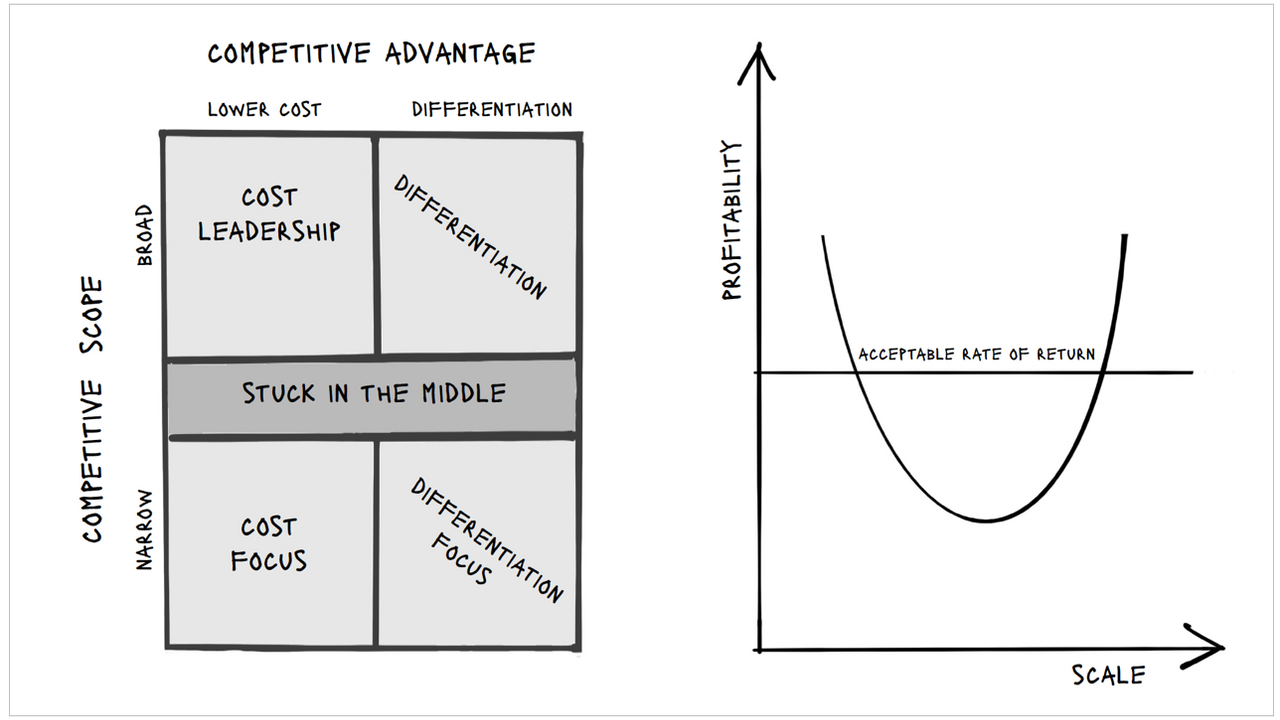Ideas, strategies and tactics
The Strategy Guy's Blog
MIMICKING STRATEGY

Winning Against One Competitor
This time next week, I will be sitting with a new client who has enjoyed a Blue Ocean (uncontested market) for some time.
In recent months a new market player has emerged. As the first market mover, my client has educated their market and acquired many early adopters as customers. The early majority of the market is predicted to come on stream in 2022. So, it is time to formulate a pricing strategy, to avoid losing future market share whilst not falling into an unprofitable price war.
Ignoring the activity of the new lower-priced entrant is foolish. Let me explain.
As a proud sailor and Aussie, I will never forget the 1983 America's Cup series.
Back then, America's ''Liberty'' was up 3-1 in the best-of-seven series. On the morning of the fifth race, the American Camp delivered boxes of cold champagne to Liberty's dock. Little did the Americans realise, their 132-year winning streak was about to end.
Liberty enjoyed a 40-second lead when "Australia II" jumped ...
BARBELL PARADOXES

With strategy, two phenomena worth considering are:
1. Barbells
Whether in life, business or an investment portfolio, capital is said to be ‘barbelled’ if 90% of your money is safe and the remaining 10% is allocated to risky investments.
Young people ask me about their crypto investments. They share that crypto is not safe - crypto is risky. I share I am not a financial advisor. However, they might consider a barbell approach - limit initial crypto investment to 10% of their net worth and when the coin goes up 10x, then sell 90% for a profit and leave 10% in the coin. Once the coin goes up 10x, repeat.
I have a pharmacy client who sells cannabis oil for a tidy profit - many patients use it repeatedly to treat insomnia, depression, anxiety and inflammation. Yesterday my client shared one of the riskiest areas of prescription medicine coming over the hill could be psychedelics to treat trauma and depression. My client imagined a barbell approach with 10% of capital being allocated into thi...
PORTFOLIO STRATEGY

What's Your Portfolio Strategy?
This week, a new strategy client asked for some clarity around their product strategy and where their marketing and sales efforts should go at the moment, given their reduced COVID-19 cash flow.
We drafted up a 2 x 3 on the whiteboard, and we mapped out a growth-share matrix. Why not create your growth-share matrix to come up with a portfolio strategy?
Step 1. On a 2 x 3 matrix, plot each of your product/service offerings by the likely market share you can achieve and the expected growth in that market space.
Step 2. Calculate an Expected Return for each offering by multiplying the potential profit level by the % chance of success. The larger the Expected Return, the larger the circle you should draw for each product.
Step 3. Now step back and assess which offerings should take priority and label them 1,2,3,4,5,6 etc. Large circles are good to prioritise, especially those in high growth markets or/and markets where gaining a dominant market share advantage is...
AGEING POPULATIONS

Maturity comes with age.
Mature people have learnt not to take their life so seriously. Paradoxically, however, people who didn't take their health seriously and create some wealth when they were young may experience fewer options and have fewer years to enjoy before they die. Ageing Populations are one of the six mega-trends I share with my conference audiences.
These mega-trends are:
- Global Warming
- Water Scarcity
- Ageing Populations
- Increasing Urbanisation
- the Rising Middle Class
- AI and Automation
Mega-trends are things that are not going to change any time soon. Mega-trends are things we can bank on, and it makes sense to formulate our strategy with mega-trends in mind.
In this blog, I have included an interview with an expert on Ageing and Finance who shares some pearls of wisdom around ageing and strategies for living a happy and fulfilling life. https://youtu.be/0pYDKEvQY6s
GLOBAL WARMING

When we think about the future, there is always a mixture of certainty and uncertainly around the corner. Generally speaking, the future is always inconvenient!
If things were certain, then strategy would be easy. Right?
I like to call things that are certain 'mega-trends, and I often share six of them with my audiences. They are:
- Global Warming
- Water Scarcity
- Ageing Populations
- Increasing Urbanisation
- The Rising Middle Class
- AI and Automation
These are six huge trends that are not going to change any time soon. Mega-trends are things we can bank on, and it makes a lot of sense to formulate our strategy with mega-trends in mind.
Below is a link to a 30 min YouTube interview I recorded with an expert on Global Warming to give us an update and the best approaches for dealing with Climate Change. https://youtu.be/LKWDSz5Caw4
STRATEGIC READING
From my visits to second-hand book shops, I have discovered that people who write inside their books finish reading them.
Less than half the people who buy a book finish it. And less than a third finish e-books.
When writing The Strategy Book, I designed it to be a deliberate blend of strategy notes and blank pages that would capture a reader's ideas, insights and goals. Most books are one-way monologues. The Strategy Book is a two-way dialogue.
Do you ever read the same book twice?
Heraclitus said, "No one steps into the same river twice."
The next time one steps into a river, it is not the same river, and they are not the same person. Rivers flow, and people grow.
I re-read my favourite books.
Why?
The same text can foster shifting and added perspectives over a lifetime. When I re-read a great book, I am a different person. I experience the book differently, and I capture and create new value.
What book are you reading right now?
Which books would you like to re-read?
I am re-reading 'A Wor...
GREAT IDEAS
Connectivity between groups of people with weak social ties gives rise to serendipitous moments of right-brain insight and idea generation. We can also gain insight when taking a shower or a walk in nature. In Great Britain, taking the day's problem solving to a local pub is a centuries-old tradition. There are 220 pubs per square mile in London but only ten pubs per square mile in Melbourne, which may account in part for Great Britain's superior track record of innovation when compared with Australia.
Third Places
Whether in pubs or cafes, or intimate hubs, collaboration is essential for innovation. Social researchers reveal that relaxed, informal, densely interconnected built environments force groups of educated people to mingle for rich exchanges of ideas. Examples of densely interconnected urban 'hives' that force people into 'third places' are Greenwich Village NYC, Berkeley or Silicon Valley CA and Soho London. Contrast this with the Australian pattern of living and working ...
THE MIDDLE

Investors Warren Buffet and Charle Munger like to invest in firms that are low-cost producers. These firms often aim to be The Cost Leader in their field. Becoming The Cost Leader results in high levels of operational efficiency. However, operational efficiency is not a strategy. Every business should aim to be operationally efficient.
Indeed, most companies have 'money lying around on the ground' waiting to be collected once processes and operations can reduce cost and create more value. Operational efficiency should be a goal for all companies, whether they choose to compete uniquely using a Cost Leadership, Differentiation or Focus approach.
When it comes to your strategic approach, it is essential not to get 'stuck in the middle.' Firms that Focus on a particular segment or Differentiate from the pack will often scale well, to a point. However, achieving massive scale is often challenging (but not impossible) without ultimately becoming a Cost Leader in some way. Firms with com...
STRATEGIC ACCOUNTANT
What is a Strategic Accountant?
I am looking forward speaking at the CA ANZ 2021 Accounting Conference this month.
I will share that Strategic Accountants make it their business to understand their client’s business. These accounting paragons focus a client's attention, energy, and investment in three ways to help them analyse the past, manage the present and lead the future.
My presentation will assist accountants to reimagine their firm, its services and their career path. Notably, I will discuss the impact of inertia, entropy and bias. I will reveal why accountants should learn to juggle and ensure their clients do the same.
PICTURE STRATEGY

After three months of researching and writing The Strategic Accountant, the book is nearly finished :-)
This week I finished my early drafts of eight chapter illustrations for the book.
Each 'picture tells a story' about how to become a Strategic Accountant.
1. Why accountants should learn to juggle.
2. Remember Enron and meet the 'gorilla that is still in the room'.
3. Find money 'on the ground' in any business.
4. Sow your seeds wisely and inherit the Kingdom.
5. Strategy offers us learning loops, if we are prepared to 'Live.Die.Repeat'.
6. Why you might like part of a Neanderthal Brain in your head.
7. 'Culture Eats Strategy for Breakfast'.
8. Future-proof your accounting firm with AI and 'bots'.
A special thanks to my wonderful reviewers: Bryan Worn, Dale Edwards, Natasha Milne, Natalie Kidcaff, James Carlopio, Oscar Hauptman, Dolores Cummins, Brad Reece and Tom Smith.


